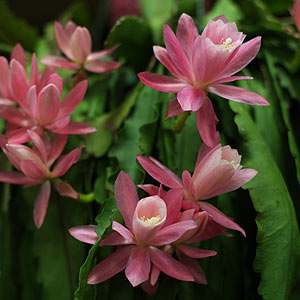
syn. Nopalxochia phyllanthoides)
One of the most attractive epiphytic cactus is Disocactus phyllanthoides is originally from South America and Mexico and is is an epiphytic cactus. However it is the hybrids that are sought after, larger flowers being the main attraction.
Fairly easy to grow this species does well in leaf mould in a hanging basket, in fact when in full flower many gardeners give these beautiful plants pride of position.
A lovely delicate pink species although red varieties are available as well.
To add a little confusion this plant is also known as the German Empress Plant, Pond Lily Cactus, NopaIxochia phyllanthoides, Cactus phyllanthoides, Epiphyllum phyllanthoides and Cereus phyllanthoides
Care
From the rainforest areas we can get a good idea of its growing requirements. This is a succulent that appreciates a moist soil mix, most growers use a mixture of peat, soil and perlite, or sharp sand. Like many epiphytic plant part shade or filtered light is best.
Moisture is essential during the warmer months and a frost free environment is essential, during winter reduce watering, although do not allow to dry out completely. You will see the foliage begin to change and shrivel if watering is required.
Flowering mainly in spring, remember to keep Disocactus phyllanthoides fairly dry , but not completely dry during the dormant period, (winter).
Propagation
Easy to grow from stem cuttings and although they will usually strike at any time of the year the best time is in spring.
- Do not be tempted to strike the long stems thinking you will get a larger plant more quickly.
- Shorter stems have a better strike rate.
- After cutting the stem, leave it in a shaded position to allow the cut to callous over, similar to many succulents.
- Cuttings will strike in the same potting mix you use for growing the parent plant. Leaf mold, perlite and sphagnum moss.
- Keep dry to just moist, this prevents damping off
- Cuttings should strike in 1 – 2 months.
- At this stage slowly bring them into more light to allow them to harden off gradually.
More Information
Disocactus phyllanthoides along with Disocactus and Epiphyllum crenatum are used in hybridisation and give us the Epiphyllum Hybrids that are widely grown.

